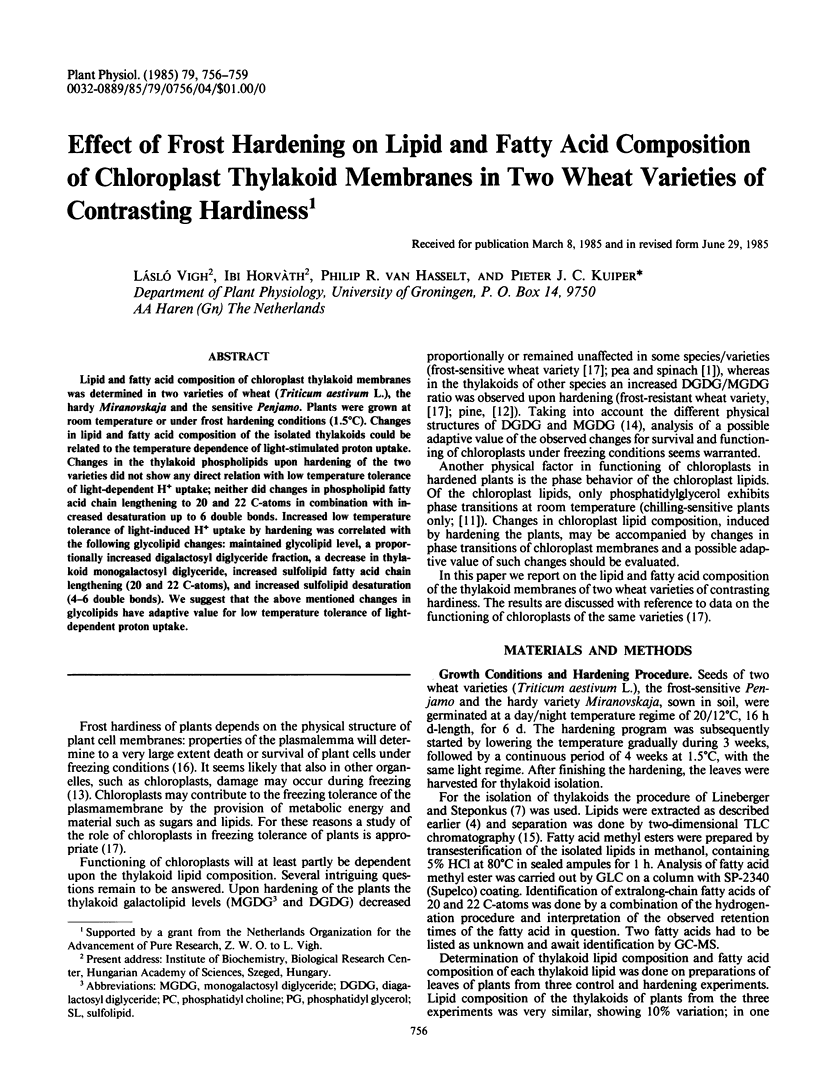Abstract
Lipid and fatty acid composition of chloroplast thylakoid membranes was determined in two varieties of wheat (Triticum aestivum L.), the hardy Miranovskaja and the sensitive Penjamo. Plants were grown at room temperature or under frost hardening conditions (1.5°C). Changes in lipid and fatty acid composition of the isolated thylakoids could be related to the temperature dependence of light-stimulated proton uptake. Changes in the thylakoid phospholipids upon hardening of the two varieties did not show any direct relation with low temperature tolerance of light-dependent H+ uptake; neither did changes in phospholipid fatty acid chain lengthening to 20 and 22 C-atoms in combination with increased desaturation up to 6 double bonds. Increased low temperature tolerance of light-induced H+ uptake by hardening was correlated with the following glycolipid changes: maintained glycolipid level, a proportionally increased digalactosyl diglyceride fraction, a decrease in thylakoid monogalactosyl diglyceride, increased sulfolipid fatty acid chain lengthening (20 and 22 C-atoms), and increased sulfolipid desaturation (4-6 double bonds). We suggest that the above mentioned changes in glycolipids have adaptive value for low temperature tolerance of light-dependent proton uptake.
Full text
PDF



Selected References
These references are in PubMed. This may not be the complete list of references from this article.
- Kuiper P. J., Stuiver B. Cyclopropane Fatty acids in relation to earliness in spring and drought tolerance in plants. Plant Physiol. 1972 Mar;49(3):307–309. doi: 10.1104/pp.49.3.307. [DOI] [PMC free article] [PubMed] [Google Scholar]
- Lineberger R. D., Steponkus P. L. Effect of freezing on the release and inactivation of chloroplast coupling factor 1. Cryobiology. 1980 Oct;17(5):486–494. doi: 10.1016/0011-2240(80)90059-0. [DOI] [PubMed] [Google Scholar]
- Livne A., Racker E. Partial resolution of the enzymes catalyzing photophosphorylation. V. Interaction of coupling factor 1 from chloroplasts with ribonucleic acid and lipids. J Biol Chem. 1969 Mar 10;244(5):1332–1338. [PubMed] [Google Scholar]
- Murata N., Yamaya J. Temperature-dependent phase behavior of phosphatidylglycerols from chilling-sensitive and chilling-resistant plants. Plant Physiol. 1984 Apr;74(4):1016–1024. doi: 10.1104/pp.74.4.1016. [DOI] [PMC free article] [PubMed] [Google Scholar]
- Oquist G. Seasonally Induced Changes in Acyl Lipids and Fatty Acids of Chloroplast Thylakoids of Pinus silvestris: A CORRELATION BETWEEN THE LEVEL OF UNSATURATION OF MONOGALACTOSYLDIGLYCERIDE AND THE RATE OF ELECTRON TRANSPORT. Plant Physiol. 1982 Apr;69(4):869–875. doi: 10.1104/pp.69.4.869. [DOI] [PMC free article] [PubMed] [Google Scholar]
- Rouser G., Fkeischer S., Yamamoto A. Two dimensional then layer chromatographic separation of polar lipids and determination of phospholipids by phosphorus analysis of spots. Lipids. 1970 May;5(5):494–496. doi: 10.1007/BF02531316. [DOI] [PubMed] [Google Scholar]


